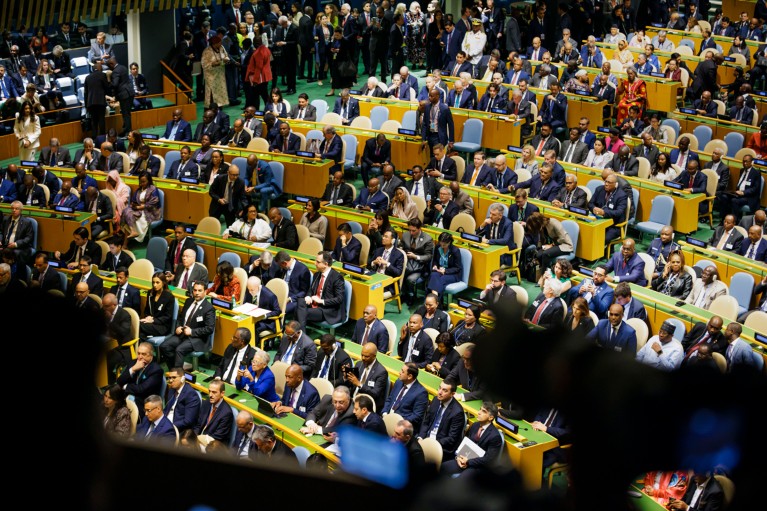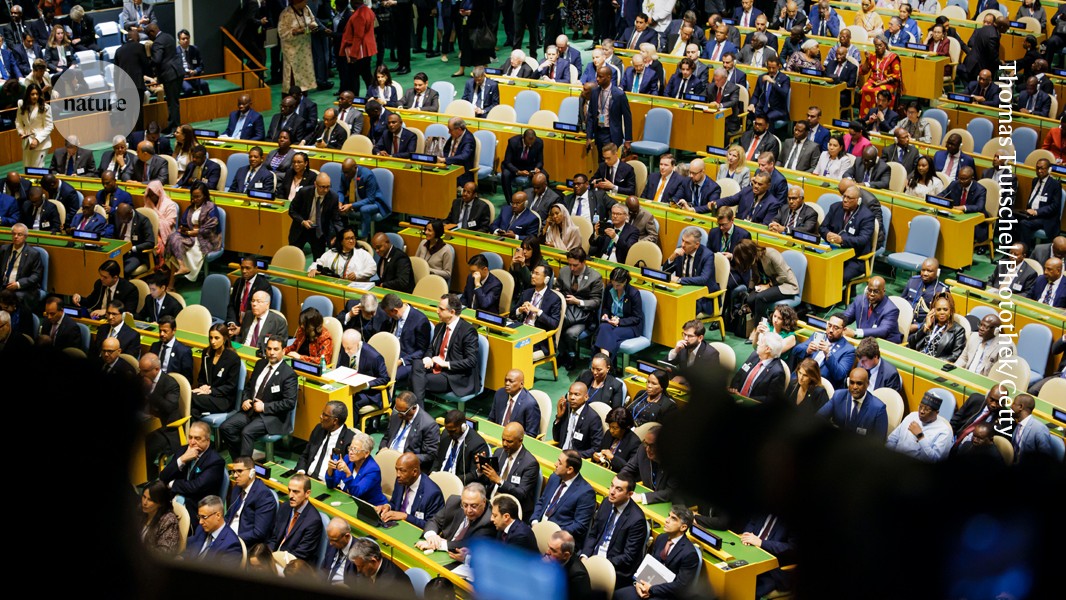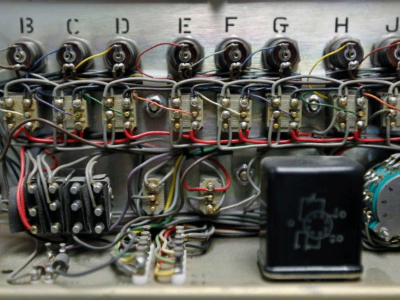
The United Nations Summit of the Future took place shortly before the start of the General Assembly (pictured).Credit: Thomas Trutschel/Photothek/Getty
Last week’s United Nations General Assembly debate saw a lot of anger. Some was directed at the UN, some at powerful nations, for their seeming inability or unwillingness to do more to tackle the world’s crises. UN secretary-general António Guterres did not mince his words in his criticism of world leaders. “Conflicts are raging and multiplying, from the Middle East to Ukraine and Sudan, with no end in sight. The climate crisis is destroying lives, devastating communities and ravaging economies. New technologies, including artificial intelligence, are being developed in a moral and legal vacuum, without governance or guardrails,” he said.
The world is in what social scientist Pedro Conceição, the editor-in-chief of the UN’s annual Human Development Report, describes as a “new uncertainty complex” of inequality, planetary pressures and polarization. In 2019, the Human Development Index, a composite measure of well-being, dropped for the first time in its more than three-decade history, although it is now recovering. It is also extremely unlikely that any of the Sustainable Development Goals (SDGs) will be achieved by the UN’s self-declared 2030 deadline.
Yet, amid the anger and frustration, a different meeting, the UN Summit of the Future, brought a sliver of hope that a better future is possible: one in which science and cooperation are front and centre. Through a document called the Pact for the Future, Guterres says that he wants to “turbocharge” climate action and efforts to meet the SDGs. The 61-page text was signed off by world leaders on 22 September. It might be one of the few remaining opportunities that the world has to correct course.
Unearthing ‘hidden’ science would help tackle the world’s biggest problems
The pact is a list of 56 pledges across 5 themes, in which world leaders promise, among other things, to provide more finance for low-income countries; work harder towards peace and security; mobilize science; and listen more to young people. The document also advocates reform of the UN’s top level of governance, as well as changes to global financial institutions such as the International Monetary Fund and the World Bank. These organizations have not changed much since the end of the Second World War, when they were established in part to support countries devastated by the conflict.
The document already has its critics. Some are disappointed that there is no mechanism for monitoring whether the pledges are kept. Others see it as another example of governments getting unnecessarily involved in peoples’ lives. Some of these points are valid, although there are a number of concrete mechanisms for following up on the pledges, including ones on improving Internet governance while protecting its autonomy, and improving the world’s financial architecture. These are also reasons why it would be wrong to dismiss the pact. The benefits of such documents are as much about the process of writing them as they are their actual content, and need to be judged by what has changed from what came before.
Several things are worthy of note. First is the fact that there is a whole section of the report devoted to science. This is not always the case with system-wide reports from the UN’s highest office. For example, advancing science is not one of the SDGs. Some argue that it doesn’t need to be, because science implicitly underpins the process of achieving all 17 goals. This is true, but science’s invisibility at the highest level also means that it risks getting ignored. Guterres recognizes this. He has re-established a board of science advisers reporting to his office, which was originally established by his predecessor Ban Ki-moon, but wasn’t continued in Guterres’s first term. Also, as Nature reported last week, researchers, including those working at the UN, are pushing national governments to establish a much greater role for evidence in policymaking (see Nature 633, 493; 2024).
How to stop a looming ‘splinternet’
Second, the pact was produced through a radical process — for governments at least — that needs to be studied for its replication potential. Starting with its founding charter in 1945, the UN has grown to oversee hundreds of treaties and conventions, which set the rules for everything from managing road traffic to conserving endangered species. These agreements often have their own legally binding text, governing structure and complicated schedule of conferences. The existence of so many individual agreements makes it challenging to tackle cross-cutting issues. Most countries have no formal mechanism for different government departments to work together to achieve the SDGs.
What was novel about the creation of the Pact for the Future is that representatives from different countries and across individual SDGs had to cooperate to produce it. SDGs, such as zero poverty or education for all, need to be achieved individually, but they also intersect — reducing poverty has an effect on education, and improving education boosts poverty reduction. In creating the pact, Guterres’s team broke through these silos, something that researchers have long been advocating and that is in fact the 17th goal: working in partnership. Researchers should help UN member states to learn from this process.
Third, and appropriate for the document’s name, the pact is a call for nations to invest more in their young people and involve them in decisions now. It is the coming generations that will “live with the consequences of our actions and inaction”, as the document says.
Ultimately, the pact will live or die on the actions of its signatory countries. If they choose to collaborate, they can achieve goals much quicker. If they build walls between them, there is a limit to what can be achieved. Guterres and his team have shown what can be achieved by prioritizing evidence and using a partnership approach. It is now up to all of us who care about sustainability, peace and security to run with the baton that has been passed to us.




